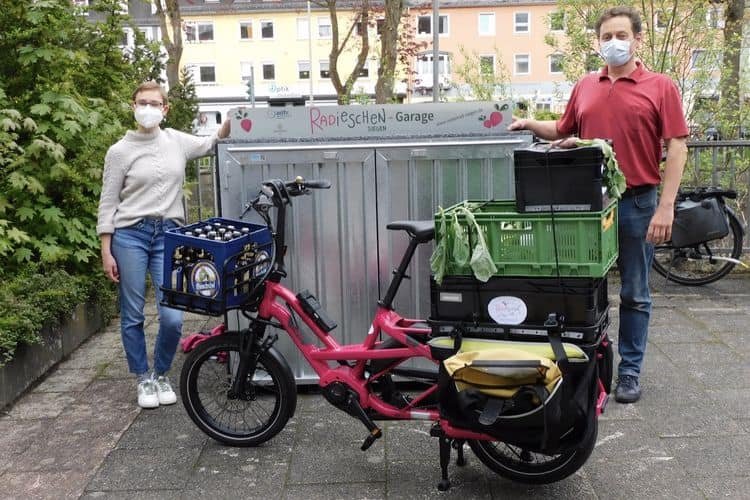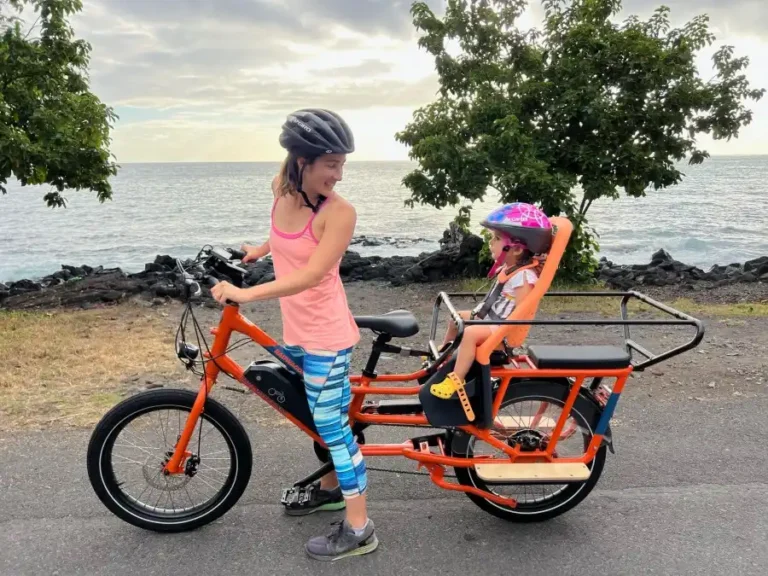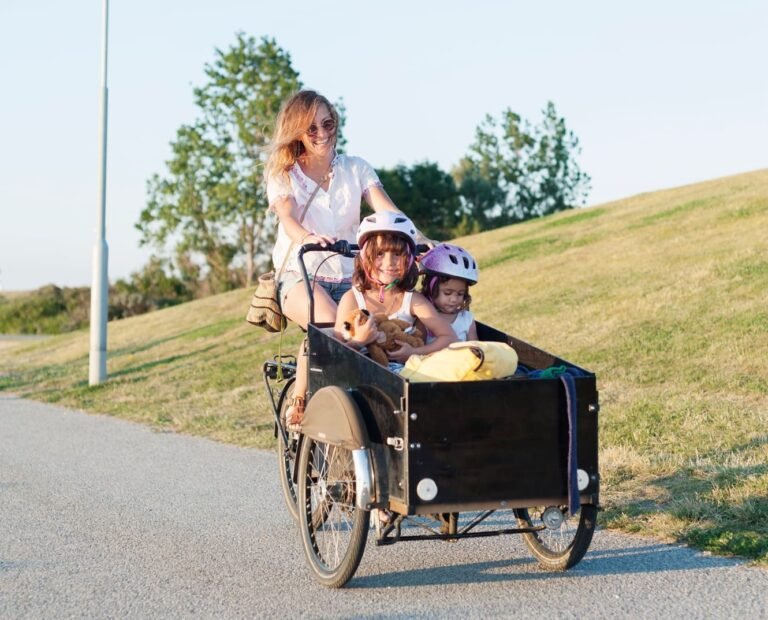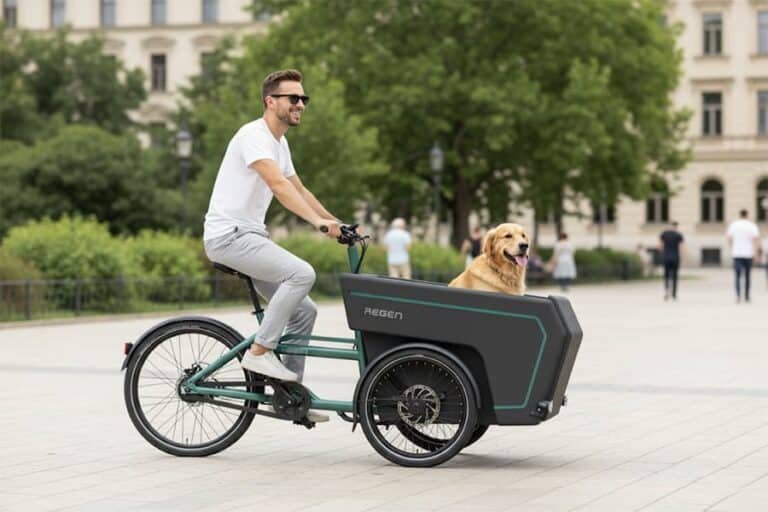Na Regen, se nás často ptají rodiny a kupující vozového parku: "Jak mohu bezpečně přepravovat své dítě na nákladním elektrokole?" Tato otázka je složitější než pouhé připevnění dětské sedačky. Týká se mezinárodní bezpečnostní normy, konstrukční omezení jízdních kol, způsoby instalacea zodpovědná jízda na koni.
Nákladní elektrokola jsou výkonná, těžká vozidla určená k přepravě nákladu i osob. S touto všestranností však přichází i odpovědnost. Ve srovnání se standardním elektrokolem přináší přeprava dětí na nákladním kole nová rizika: vyšší hmotnost, změněnou manipulaci a zranitelnost dětských pasažérů.
V tomto článku se budeme opírat o naše inženýrské zkušenosti ve společnosti Regen, spolu s Evropské normy (EN 14344, EN 15194, DIN 79010) a reálné rodinné postupy, aby vysvětlil, jak zajistit co nejbezpečnější a nejspolehlivější přepravu dětí na nákladních elektrokolech.
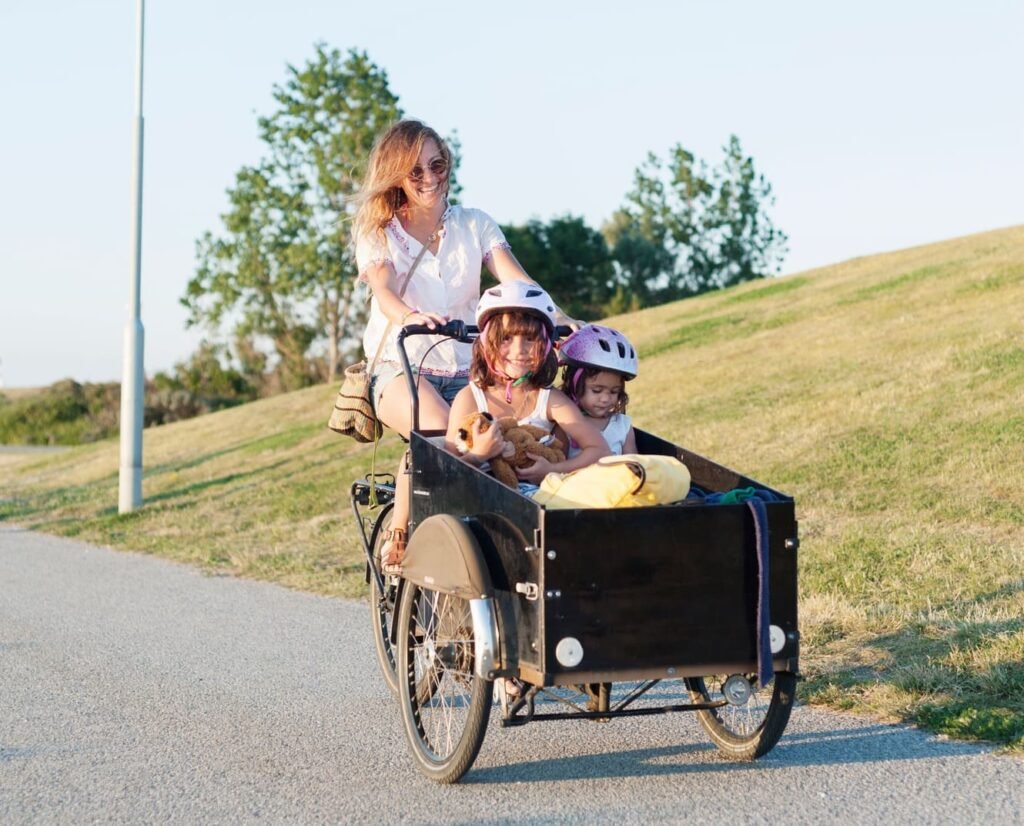
Porozumění standardům: Bezpečnost především
EN 14344: Dětské sedačky na kolo
EN 14344 je evropská norma, která upravuje bezpečnost dětských cyklosedaček. Stanovuje:
- Maximální hmotnost dítěte (obvykle 22 kg)
- Požadavky na postroj (tříbodový nebo pětibodový)
- Ochrana nohou a chodidel
- Zkoušky mechanické pevnosti a odolnosti
Každá dětská sedačka namontovaná na nákladním elektrokole by měla být. certifikováno podle EN 14344. To zaručuje, že sedadlo prošlo nárazovými, únavovými a stabilitními testy.
EN 15194/EN 17860 : Systém E-Bike Standard
Zatímco norma EN 14344 se vztahuje na sedadlo, EN 15194 upravuje elektrickou a mechanickou bezpečnost samotného elektrokola. Pokud je vaše nákladní elektrokolo označeno značkou CE a splňuje normu EN 15194, můžete se spolehnout, že motor, řídicí jednotka a elektrické systémy jsou bezpečné pro rodinné použití.
DIN 79010: Nákladní kola Konstrukční bezpečnost
Norma DIN 79010, která byla vydána v Německu v roce 2020, je první normou, která se zabývá speciálně nákladními koly. Stanovuje:
- Maximální přípustná hmotnost (250 kg u dvoukolových vozidel, 300 kg u tříkolových vozidel)
- Zkouška únavy rámu při zatížení dětským pasažérem
- Požadavky na brzdnou dráhu
- Simulace nárazu a stability
Tato norma jde nad rámec tradičního testování jízdních kol a odráží skutečné nároky na rodinnou a komerční nákladní cyklistiku. Ve společnosti Regen navrhujeme a testujeme naše rámy s ohledem na tyto případy zatížení.
Regionální zákony o přilbách
V EU musí dětské přilby splňovat následující požadavky. CS 1078. Ve Spojených státech Standard CPSC platí. Místní zákony se liší, ale z technického a rodičovského hlediska, přilby jsou vždy povinné.
Možnosti sezení pro děti na Nákladní elektrokola
Různé typy nákladních kol (Long John/front-loader, longtail, trike) podporují různé systémy sezení. Výběr toho správného záleží na dítěti. věk, velikost a hmotnost.
1. Přední skříňová sedadla (Long John/Bakfiets Style)
- Nastavení: Děti sedí v předním nákladovém prostoru s lavicemi a popruhy.
- Bezpečnostní prvky: Bočnice, stříška, tříbodové nebo pětibodové pásy.
- Nejlepší pro: 1-8 let, zvláště pokud se jedná o dvě a více dětí.
- Výhoda: Nízko položené těžiště, které mohou rodiče snadno sledovat.
(Související čtení: Vysvětlení komponentů nákladního kola - kde rozbíjíme krabice, regály a další rámové konstrukce.)
2. Zadní dětské sedačky (dlouhá nákladní kola)
- Nastavení: Certifikovaná dětská autosedačka připevněná k vyztuženému zadnímu nosiči.
- Normy: Musí splňovat EN 14344 požadavky.
- Nejlepší pro: 9 měsíců až 6 let (do ~22 kg).
- Zkontrolujte: Nosič musí být dimenzován tak, aby unesl hmotnost sedačky i dítěte.
3. Lavice s polštáři a zábradlím
- Nastavení: Polstrovaná lavice s ochrannými zábranami a opěrkami nohou.
- Nejlepší pro: 5-10 let (když jsou příliš velké pro sedačky pro batolata).
- Bezpečnost: Zábradlí zabraňují dětem, aby se vykláněly; chrániče nohou brání prstům dosáhnout na kola.
4. Nákladní přívěsy (volitelně)
- Nastavení: Samostatný přívěs připojený ke kolu.
- Nejlepší pro: Kojenci s vložkami ve stylu autosedačky nebo více dětí.
- Výhody: Stabilní, odolný proti povětrnostním vlivům.
- Nevýhody: Obtížnější manévrování a parkování.
Pokyny pro věk a hmotnost
| Věk dítěte | Doporučené nastavení | Normy, které je třeba zkontrolovat | Hmotnostní limit |
|---|---|---|---|
| 0-9 měsíců | Nedoporučuje se | - | - |
| 9-36 měsíců | Certifikovaná dětská autosedačka | EN 14344 | ≤ 22 kg |
| 3-6 let | Dětská sedačka nebo přední box | EN 14344, DIN 79010 | ≤ 22 kg |
| 6-10 let | Lavice + zábradlí, podnožky | DIN 79010 | Až do nosiče/boxu kola |
(Další pokyny: Točivý moment a výkon u nákladních elektrokol - proč má velké zatížení vliv na manipulaci a proč je při přepravě dětí nezbytný správný točivý moment motoru.)
Základní bezpečnostní vybavení
- Přilba: Musí splňovat požadavky normy EN 1078 (EU) nebo CPSC (USA).
- Postroj: Batolata vždy připoutejte pětibodovým bezpečnostním pásem.
- Opěrky nohou/ochrany: Zabraňte zachycení v ramenech nebo řetězech.
- Ochranné lišty nebo stěny skříně: Zastavte pády nebo prudké pohyby.
- Dešťová stříška nebo kryt proti dešti: Dodává pohodlí a ochranu.
Nápad na ilustraci: Nákres s označením nákladního longtailu s jedním batoletem v zadní dětské sedačce a jedním starším dítětem na polstrované lavici se zábranami.
Alt text: "Dětské sedačky na nákladním elektrokole, včetně certifikované zadní dětské sedačky a lavičky s ochrannými lištami."
Osvědčené postupy při instalaci
- Používejte pouze sedadla a nosiče schválené výrobcem.
- Šrouby utáhněte doporučeným utahovacím momentem; použijte pojistné podložky.
- Těžší děti umístěte blíže k jezdci, abyste udrželi rovnováhu.
- Po instalaci vyzkoušejte kolo bez dětí a zkontrolujte, zda nedochází k rušení.
- Před každou jízdou: zkontrolujte popruhy, šrouby a zámky popruhů.
Jízda s dětmi na palubě
- Omezte rychlost: Mnoho výrobců doporučuje při přepravě dětí rychlost ≤ 20 km/h.
- Brzděte dříve: Těžší náklad prodlužuje brzdnou dráhu.
- Plynulá jízda: Vyhněte se ostrým zatáčkám a agresivnímu zrychlování.
- Před montáží stabilizujte: Před usazením/vyjmutím dětí vždy držte nebo použijte dvojitý stojan.
- Krátké adaptační jízdy: Začněte s malými smyčkami, dokud se děti nebudou cítit bezpečně.
(Viz také: Mají nákladní kola odpružení? - pochopení toho, jak odpružené vidlice zvyšují pohodlí při přepravě dětí.)
Příklady z reálného světa
- Školní jízdy v Amsterdamu: Rodiny používají kola s předním nosičem, dvěma lavičkami a stříškou proti dešti, na které se bezpečně usadí tři děti.
- Berlínské dlouhé ocasy: Batole jezdí na zadní sedačce Yepp Maxi, zatímco sedmileté dítě používá polstrovanou lavici s kolejnicemi.
- Dodávky do Paříže: Rodiče kombinují přepravu dítěte s nákladem a používají boční lišty a brašny pro zajištění stability.
Nejčastější chyby, kterých se vyvarujte
- Používání necertifikovaných dětských sedaček
- Povolení jízdy dětí bez přileb
- Překročení hmotnostních limitů stojanu
- Nechat děti jezdit bez opěrek nohou nebo zábradlí.
- Ignorování kontroly šroubů před jízdou
Inženýrský pohled společnosti Regen: Zapracování bezpečnosti do návrhu
Jako výrobce jsme ve společnosti Regen začlenili bezpečnost dětí do našich systémů nákladních kol již ve fázi návrhu:
- Modulární rozhraní pro dětské sedačky (MIK, normy pro stojany ISO 11243).
- Nadměrná konstrukce rámu s únavovou zkouškou nad rámec normy DIN 79010.
- Nadbytečné bezpečnostní faktory v namáhaných místech (uchycení nosiče, sváry).
- Ověřování třetí stranou prostřednictvím laboratoří, jako je EFBE Prüftechnik.
- Volitelná vylepšení jako jsou ochranné lišty, prodloužené opěrky nohou a stříšky proti povětrnostním vlivům.
- Školení zákazníků s předávacími příručkami týkajícími se instalace a bezpečnosti přepravy dětí.
(Související téma: Vysvětlení materiálů rámu nákladního kola - proč jsou hliníkové slitiny a tepelně zpracovaná ocel důležité pro bezpečnost dětí.)
Závěr: Bezpečné, praktické, vhodné pro rodinu
Při správném usazení, správné instalaci a zodpovědné jízdě může být nákladní elektrokolo pro děti stejně bezpečné a praktické jako jakékoli jiné rodinné vozidlo.
Ve společnosti Regen věříme, že bezpečnost je součástí každého rámu, nosiče a komponenty, takže když posadíte své dítě, můžete jezdit s jistotou.
Pokud jste distributor, správce vozového parku nebo rodina, která uvažuje o nákladních kolech, kontaktujte nás. Náš tým inženýrů a projektantů vám pomůže nakonfigurovat systém, který splňuje jak regulační normy, tak každodenní potřeby vaší rodiny.
Reference
- Bobike. (n.d.). Certifikovaná sedadla. Převzato z https://bobike.com/products/certified_seats
- Novinky z cyklistického průmyslu. (2023). Tern představuje třetí generaci nákladního kola GSD testovaného podle normy DIN 79010. Převzato z https://cyclingindustry.news/tern-unveils-din-79010-tested-third-gen-gsd-cargo-bike
- DIN Media. (2020). DIN 79010: Jízdní kola - Přepravní a nákladní jízdní kola. Převzato z https://www.dinmedia.de/en/standard/din-79010/315466805
- Libbri. (2023). Jak Libbri testuje bezpečnost našich nákladních elektrokol. Převzato z https://libbri.ch/en/blogs/infos/comment-libbri-teste-la-securite-de-nos-velos-cargos-electriques
- SGS. (2024). Aktuální informace o normách EU pro nákladní kola. Webinář. Převzato z https://www.sgs.com/en/webinars/2024/02/update-on-eu-cargo-bike-standards
- Kola Tern. (nd). Průvodce dětskou sedačkou. Převzato z https://www.ternbicycles.com/en/explore/product-safety/tern-child-seat-guide
- Kola Tern. (nd). Jak testujeme bezpečnost našich elektrokol. Převzato z https://www.ternbicycles.com/us/explore/how-we-test-our-e-bikes-safety
- Kola Tern. (nd). Použití dětských sedaček na vozidle GSD Gen 2. Převzato z https://www.ternbicycles.com/us/explore/pets-and-passengers/using-child-seats-gsd-gen-2



